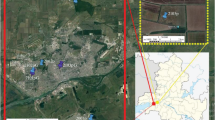Abstract
The complete polymerization of phenols and proteins (one of the processes involved in the formation of humic substances) was explained. It was shown that fly (Bibio marci) larvae and earthworms (Aporrectodea caliginosa) participate in the complete polymerization of phenols and proteins. In a laboratory experiment, invertebrates participated in the degradation of organic matter and the synthesis of humic substances, which was proved in experiments with 14C-labeled phenols and proteins. The same organic substances (phenols and proteins) without the impact of invertebrates were used as the control substances. The distributions of the 14C isotope in alkaline extracts separated by solubility in acids (humic and fulvic acids) was compared to those of the control substances. The portion of the 14C isotope in the humic acids in the excrements of Bibio marci was higher than that in the control substances. The content of 14C-labeled humic substances in the excrements of the earthworm Aporrectodea caliginosa exceeded the control values only in the experiment with proteins. When clay material was added to the organic substances, the portion of the 14C isotope in the humic acids increased in both experiments with phenols and proteins. When these substrates passed through the digestive tracts of the invertebrates, the polymerization of organic substances and the inclusion of proteins and phenols into humic acids occurred.
Similar content being viewed by others
References
E. V. Abakumov and I. Frouz, “Evolution of the Soil Humus Status on the Calcareous Neogene Clay Dumps of the Sokolov Quarry Complex in the Czech Republic,” Pochvovedenie, No. 7, 773–779 (2009) [Eur. Soil Sci. 42 (7), 718–724 (2009)].
L. N. Aleksandrova, Soil Organic Matter and Its Transformation (Nauka, Leningrad, 1980) [in Russian].
N. P. Bityutskii and E. I. Maiorov, “Promoting Role of Earthworm Excrements in the Transformation of Plant Residues,” in Proceedings of the V International Conference “Humic Substances in the Biosphere,” Moscow, Russia, 2007 (Moscow, 2007), pp. 71–75 [in Russian].
N. P. Bityutskii, A. N. Solov’eva, E. I. Lukina, et al., “The Effect of Earthworms on the Population of Microorganisms and Enzyme Activity in Soil,” Pochvovedenie, No. 1, 82–91 (2005) [Eur. Soil Sci. 38 (1), 73–82 (2005)].
D. S. Orlov, L. K. Sadovnikova, and N. I. Sukhanova, Soil Chemistry (Mosk. Gos. Univ., Moscow, 2005) [in Russian].
I. D. Komissarov and L. F. Loginov, “Skeletal Structure of Humic Acids,” in Peat, Its Properties, and Potential Applications (Minsk, 1981) [in Russian].
M. M. Kononova, Problem of Soil Humus and the Current Challenges of Its Study (Moscow, 1951) [in Russian].
S. N. Chukov, Structural and Functional Parameters of Soil Organic Matter under Anthropogenic Impact (St. Peterb. Gos. Univ., St. Petersburg, 2001) [in Russian].
G. Bachelier, “Experimental Study on the Effect of Animals on the Humification of Plant Material: I. First Experiment and Preliminary Conclusions,” Trav. Doc Orstrom 14, 1–75 (1972).
I. Barois, G. Villemin, P. Lavelle, and F. Toutain, “Transformation of the Soil Structure through Pontoscolex coethrurus (Oligochaeta) Intestinal Tract,” Geoderma 56, 57–66 (1993).
J. Frouz, B. Keplin, V. Pizl, et al., “Soil Biota and Upper Soil Layer Development in Two Contrasting Post-Mining Chronosequences,” Ecol. Eng. 17, 275–284 (2001).
J. Frouz, V. Kristufek, X. Li, et al., “Changes in Amount of Bacteria during Gut Passage of Leaf Litter and during Coprophagy in Three Species of Bibionidae (Diptera) Larvae,” Folia Microbiol. 48, 535–542 (2003).
W. Flaig, “Generation of Model Chemical Precursors,” in Humic Substances and Their Role in the Environment, Ed. by E. H. Frimmel and R. F. Christman (Wiley, New York, 1988), pp. 75–92.
B. S. Griffiths, S. Wood, and M. V. Cheshire, “Mineralization of 14C-Labelled Plant Material by Porcelio scaber (Crustacea: Isopoda),” Pedobiologia 33, 355–360 (1989).
R. Hartenstein, “Soil Macroinvertebrates, Aldehyde Oxidase, Catalase, Cellulase and Peroxidase,” Soil Biol. Biochem. 14, 387–391 (1982).
M. Hušák, J. Frouz, and J. Had, “Can Earthworm Gut Passage Modify Clay Minerals Structure? a Preliminary Result,” in Soil Zoology in Central Europe, Ed. by K. Tajovsky (ISB, Ceské Budéjovice, in press).
R. Ji and A. Brune, “Transformation and Mineralization of C-14-Labeled Cellulose, Peptidoglycan, and Protein by the Soil-Feeding Termite Cubitermes Orthognathus,” Biol. Fertil. Soils 33, 166–174 (2001).
K. S. Johnson and G. W. Felton, “Potential Influence of Midgut pH and Redox Potential on Protein Utilization in Insect Herbivores,” Arch. Insect Biochem. Physiol. 32, 85–105 (1996).
A. Kappler, R. Ji, and A. Brune, “Synthesis and Characterization of Specifically 14C-Labeled Humic Model Compounds for Feeding Trials with Soil Feeding Termites,” Soil Biol. Biochem. 32, 1271–1280 (2000).
M. Schnitzer, Environmental Biogeochemistry, Ed. by J. O. Niriagu (1976), Vol. 1, pp. 89–107.
F. J. Stevenson, Cycles of Soil Carbon, Nitrogen, Phosphorus, Sulfur, Micronutrients (Wiley, New York, 1982).
F. J. Stevenson, Humus Chemistry: Genesis, Compositions, Reactions (Wiley, New York, 1994).
Author information
Authors and Affiliations
Additional information
Original Russian Text © J. Frouz, X. Li, A. Brune, V. Pizl, E.V. Abakumov, 2011, published in Pochvovedenie, 2011, No. 8, pp. 973–977.
Rights and permissions
About this article
Cite this article
Frouz, J., Li, X., Brune, A. et al. Effect of soil invertebrates on the formation of humic substances under laboratory conditions. Eurasian Soil Sc. 44, 893–896 (2011). https://doi.org/10.1134/S1064229311080047
Received:
Accepted:
Published:
Issue Date:
DOI: https://doi.org/10.1134/S1064229311080047




